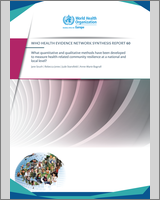NCBI Bookshelf. A service of the National Library of Medicine, National Institutes of Health.
Abstract
Community resilience is the ability of communities and groups to adapt and thrive in response to external stressors. Building resilient communities as a strategy for population health requires assessment of personal and collective capacities alongside vulnerabilities. This report examines what quantitative and qualitative methods can be used to measure health-related community resilience at national and local levels. Evidence from a rapid review of 33 studies highlighted various methodological challenges. Measurement strategies, mostly drawn from the field of community disaster resilience, include population-level frameworks, mixed methods assessment tools, and qualitative and participatory case studies. The main conclusions are that measurement of health-related community resilience should cover multiple domains (economic, social, health, skills, political and environment) and consider local context and assets. Three stages of policy development are suggested: selection of a set of key indicators to collect data on community resilience, creation of a learning network to share knowledge and tools, and development of a comprehensive measurement framework.
Contents
Suggested citation:
South J, Jones R, Stansfield J, Bagnall A-M. What quantitative and qualitative methods have been developed to measure health-related community resilience at a national and local level? Copenhagen: WHO Regional Office for Europe; 2018 (Health Evidence Network (HEN) synthesis report 60).
The Health Evidence Network
The Health Evidence Network (HEN) is an information service for public health decision-makers in the WHO European Region, in action since 2003 and initiated and coordinated by the WHO Regional Office for Europe under the umbrella of the WHO European Health Information Initiative (a multipartner network coordinating all health information activities in the WHO European Region).
HEN supports public health decision-makers to use the best available evidence in their own decision-making and aims to ensure links between evidence, health policies and improvements in public health. The HEN synthesis report series provides summaries of what is known about the policy issue, the gaps in the evidence and the areas of debate. Based on the synthesized evidence, HEN proposes policy considerations, not recommendations, for policy-makers to formulate their own recommendations and policies within their national context.
HEN and the Evidence for health and well-being in context project
The Evidence for health and well-being in context project was initiated at the WHO Regional Office for Europe in response to Members States' consideration of Health 2020, the European policy framework for health and well-being. Health 2020 includes a number of promising values-based health concepts that are difficult to measure and report on. In response to this challenge, the WHO Regional Office for Europe convened an expert group to investigate ways of enhancing Health 2020 monitoring and reporting. The first meeting of the Expert Group on Enhancing Health 2020 Monitoring and Reporting was convened by the WHO Regional Office for Europe on 1–2 September 2016. Among other things, the Expert Group recommended commissioning this HEN report outlining qualitative and quantitative methods developed to measure community empowerment at a national level.
Address requests about publications of the WHO Regional Office for Europe to:
Publications
WHO Regional Office for Europe
UN City, Marmorvej 51
DK-2100 Copenhagen Ø, Denmark
Alternatively, complete an online request form for documentation, health information, or for permission to quote or translate, on the Regional Office website (http://www.euro.who.int/pubrequest).
ISSN 2227-4316
ISBN 978 92 890 5362 4
© World Health Organization 2018
All rights reserved. The Regional Office for Europe of the World Health Organization welcomes requests for permission to reproduce or translate its publications, in part or in full.
The designations employed and the presentation of the material in this publication do not imply the expression of any opinion whatsoever on the part of the World Health Organization concerning the legal status of any country, territory, city or area or of its authorities, or concerning the delimitation of its frontiers or boundaries. Dotted lines on maps represent approximate border lines for which there may not yet be full agreement.
The mention of specific companies or of certain manufacturers' products does not imply that they are endorsed or recommended by the World Health Organization in preference to others of a similar nature that are not mentioned. Errors and omissions excepted, the names of proprietary products are distinguished by initial capital letters.
All reasonable precautions have been taken by the World Health Organization to verify the information contained in this publication. However, the published material is being distributed without warranty of any kind, either express or implied. The responsibility for the interpretation and use of the material lies with the reader. In no event shall the World Health Organization be liable for damages arising from its use. The views expressed by authors, editors, or expert groups do not necessarily represent the decisions or the stated policy of the World Health Organization.
- NLM CatalogRelated NLM Catalog Entries
- What quantitative and qualitative methods have been developed to measure health-...What quantitative and qualitative methods have been developed to measure health-related community resilience at a national and local level?
Your browsing activity is empty.
Activity recording is turned off.
See more...
